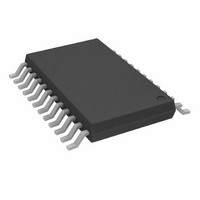AD7366BRUZ-5 Analog Devices Inc, AD7366BRUZ-5 Datasheet - Page 16

AD7366BRUZ-5
Manufacturer Part Number
AD7366BRUZ-5
Description
IC ADC 12BIT DUAL 500KSPS 24-TSS
Manufacturer
Analog Devices Inc
Datasheet
1.AD7367BRUZ-5.pdf
(28 pages)
Specifications of AD7366BRUZ-5
Data Interface
DSP, MICROWIRE™, QSPI™, Serial, SPI™
Design Resources
Driving the AD7366/7 Bipolar SAR ADC in Low-Distortion DC-Coupled Appls (CN0042)
Number Of Bits
12
Sampling Rate (per Second)
500k
Number Of Converters
2
Power Dissipation (max)
88.8mW
Voltage Supply Source
Analog and Digital, Dual ±
Operating Temperature
-40°C ~ 85°C
Mounting Type
Surface Mount
Package / Case
24-TSSOP (0.173", 4.40mm Width)
Resolution (bits)
12bit
Input Channel Type
Single Ended
Supply Voltage Range - Analogue
4.75V To 5.25V, ± 11.5V To ± 16.5V
Supply Voltage Range - Digital
2.7V To 5.25V,
Sampling Rate
1MSPS
Rohs Compliant
Yes
Lead Free Status / RoHS Status
Lead free / RoHS Compliant
For Use With
EVAL-AD7366CBZ - BOARD EVALUATION FOR AD7366
Lead Free Status / RoHS Status
Lead free / RoHS Compliant, Lead free / RoHS Compliant
Available stocks
Company
Part Number
Manufacturer
Quantity
Price
Company:
Part Number:
AD7366BRUZ-5
Manufacturer:
ADI
Quantity:
1 000
Part Number:
AD7366BRUZ-5
Manufacturer:
ADI/亚德诺
Quantity:
20 000
Company:
Part Number:
AD7366BRUZ-5-RL7
Manufacturer:
ADI
Quantity:
1 000
AD7366-5/AD7367-5
THEORY OF OPERATION
CIRCUIT INFORMATION
The AD7366-5/AD7367-5 are fast, dual, 2-channel, 12-/14-bit,
bipolar input, simultaneous sampling, serial ADCs. The
AD7366-5/AD7367-5 can accept bipolar input ranges of ±10 V
and ±5 V. They can also accept a 0 V to 10 V unipolar input
range. The AD7366-5/AD7367-5 require V
supplies for the high voltage analog input structure. These
supplies must be greater than or equal to the analog input range
(see Table 7 for the minimum requirements on these supplies
for each analog input range). The AD7366-5/AD7367-5 require
a low voltage 4.75 V to 5.25 V V
Table 7. Reference and Supply Requirements for Each
Analog Input Range
Selected
Analog Input
Range (V)
±10
±5
0 to +10
Each AD7366-5/AD7367-5 contains two on-chip, track-and-hold
amplifiers, two successive approximation ADCs, and a serial
interface with two separate data output pins. The device is housed
in a 24-lead TSSOP, offering the user considerable space-saving
advantages over alternative solutions.
The AD7366-5/AD7367-5 require a CNVST signal to start a
conversion. On the falling edge of CNVST , both track-and-
holds are placed into hold mode, and the conversions are
initiated. The BUSY signal goes high to indicate that the
conversions are taking place. The clock source for each
successive approximation ADC is provided by an internal
oscillator. The BUSY signal goes low to indicate the end of
conversion. On the falling edge of BUSY, the track-and-hold
returns to track mode. Once the conversion is finished, the
serial clock input accesses data from the part.
The AD7366-5/AD7367-5 have an on-chip 2.5 V reference that
can be disabled when an external reference is preferred. If the
internal reference is to be used elsewhere in a system, the output
from D
REFSEL pin must be tied to a high or low logic state to select
either the internal or external reference option.
CAP
A and D
Reference
Voltage (V)
+2.5
+3.0
+2.5
+3.0
+2.5
+3.0
CAP
B must first be buffered. On power-up, the
Full-Scale
Input
Range (V)
±10
±12
±5
±6
0 to +10
0 to +12
CC
supply to power the ADC core.
AV
+5
+5
+5
+5
+5
+5
DD
CC
and V
(V)
SS
Minimum
V
±10
±12
±5
±6
+10/AGND
+12/AGND
dual
DD
/V
SS
(V)
Rev. A | Page 16 of 28
If the internal reference is the preferred option, the user must
tie the REFSEL pin logic high. Alternatively, if REFSEL is tied to
GND, an external reference can be supplied to both ADCs
through the D
The analog inputs are configured as two single-ended inputs for
each ADC. The various different input voltage ranges can be
selected by programming the RANGE bits as shown in Table 8.
CONVERTER OPERATION
The AD7366-5/AD7367-5 have two successive approximation
ADCs, each based around two capacitive DACs. Figure 16 and
Figure 17 show simplified schematics of an ADC in acquisition
and conversion phases, respectively. The ADC is comprised of
control logic, a SAR, and a capacitive DAC. In Figure 16 (the
acquisition phase), SW2 is closed, SW1 is in Position A, the
comparator is held in a balanced condition, and the sampling
capacitor arrays acquire the signal on the input.
When the ADC starts a conversion (see Figure 17), SW2 opens,
and SW1 moves to Position B, causing the comparator to
become unbalanced. The control logic and the charge redis-
tribution DAC is used to add and subtract fixed amounts of
charge from the sampling capacitor to bring the comparator
back into a balanced condition. When the comparator is
balanced again, the conversion is complete. The control logic
generates the ADC output code.
AGND
AGND
V
V
IN
IN
CAP
SW1
SW1
A and D
A
A
Figure 16. ADC Acquisition Phase
Figure 17. ADC Conversion Phase
B
B
CAP
SW2
SW2
B pins.
COMPARATOR
COMPARATOR
CAPACITIVE
CAPACITIVE
CONTROL
CONTROL
LOGIC
LOGIC
DAC
DAC














